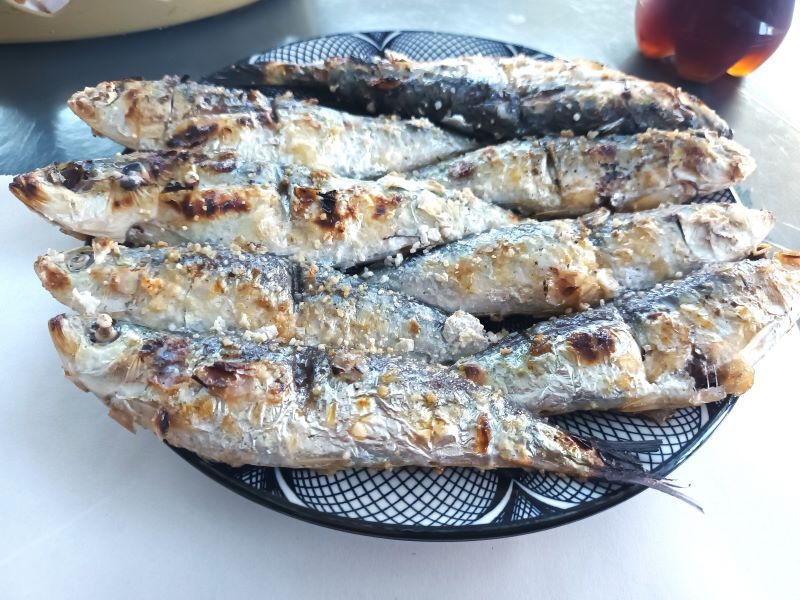Safi – Morocco's Sardine Capital
- Vedran Obućina
- Aug 24
- 5 min read
Perched on Morocco’s windswept Atlantic coast, Safi (or Esfi, in Arabic) has long been known as the country’s pottery capital, but ask any local and they’ll tell you the city’s true treasure is pulled straight from the sea. Every morning, fishing boats unload crates brimming with shimmering sardines, the small silver fish that have earned Safi its reputation as the sardine capital of the world. For generations, the rhythm of life here has been tied to the tides, and nowhere is this more evident than in the city’s bustling port, where the salty air mingles with the aroma of freshly grilled catch.

At dawn, Safi’s harbour erupts into a symphony of sound and motion: the slap of waves against wooden hulls, the guttural cries of seagulls circling overhead (and underhead), and the animated bargaining of fishermen and traders haggling over crates of glistening sardines. The wise and cunning sight of ever-present cats adds to this atmosphere that repeats every single day.

Nets heavy with the night’s catch are hauled ashore, while porters weave through the throng with baskets balanced high, dodging fishmongers shouting prices and buyers eager to claim the freshest haul. The air is thick with salt, diesel, and the smoky scent of grills already firing up nearby, as the entire waterfront becomes a stage for the city’s oldest daily ritual—a living testament to Safi’s identity as Morocco’s sardine capital.

Safi’s sardines are more than just a source of livelihood—they are the centerpiece of the local table. The most beloved preparation is simple and timeless: sardines marinated in chermoula—a punchy mix of garlic, paprika, cumin, parsley, coriander, and preserved lemon—before being grilled over open flames. Others prefer them minced and spiced into delicate kefta, simmered in a clay tagine with ripe tomatoes. Eaten with nothing more than warm khobz bread and a squeeze of lemon, these dishes capture the essence of Moroccan coastal cooking: fresh, bold, and deeply communal.

For visitors, to eat sardines in Safi is to experience the city’s soul. Families gather in seaside cafés where platters of fish arrive straight from the grill, their skin crisped by charcoal and their flesh meltingly tender. The flavors are humble yet unforgettable, carrying with them the story of a port city where tradition, sea, and spice converge. In Safi, sardines are not just food—they are heritage on a plate.

Chermoula is the beating heart of Moroccan seafood cooking, a fragrant marinade that transforms the simplest fish into a dish full of depth and character. Made by blending fresh herbs like parsley and cilantro with garlic, paprika, cumin, lemon juice, and a drizzle of olive oil, it strikes a perfect balance between brightness and earthiness. In Safi, sardines are often bathed in this vivid mixture before being grilled or fried, allowing the spices to infuse the flesh with smoky, citrusy warmth. More than just a seasoning, chermoula is a tradition passed from kitchen to kitchen, a reminder that in Moroccan cuisine, the soul of the dish often lies in its spices.
Gastronomy and pottery are inseparable, each enriching the other in a uniquely local way.

The city’s renowned potters shape the tagines, bowls, and plates that not only carry Safi’s artistic identity but also define how its food is prepared and savored. A sardine kefta tagine, for instance, gains its depth of flavor from slow cooking in clay, where the vessel’s porous texture allows spices and steam to mingle in harmony. When these earthy ceramics meet the bold flavors of the sea, they create a dialogue between craft and cuisine, reminding visitors that in Safi, food is not just eaten, but experienced through the artistry of both the kitchen and the kiln.

Safi’s medina, nestled against its ancient city walls, is a maze of narrow alleys where daily life unfolds much as it has for centuries. The scent of freshly baked bread drifts from communal ovens, where families bring their rounds of khobz—golden, crusty loaves that are the cornerstone of every Moroccan meal. Women chat while waiting for their bread to bake, children dart through stone passageways, and vendors set out baskets of olives, spices, and herbs along the worn cobblestones. Above it all, the imposing walls that once defended the city now stand as silent witnesses to Safi’s layered history, encircling a living medina where tradition, flavor, and heritage remain deeply intertwined.

Strolling along Safi’s seaside promenade is a feast for the senses, where the vast Atlantic unfurls in shades of deep blue and the salty breeze carries with it an intoxicating mix of scents. The sharp tang of the ocean blends with the smoky aroma of sardines grilling over charcoal at street stalls, while nearby cafés release whiffs of fresh mint tea and sweet pastries dusted with anise and sesame. On warm evenings, the promenade comes alive with families, couples, and children savoring the cool air, as the fragrance of jasmine from garden corners mingles with the ever-present perfume of the sea—a reminder that in Safi, even a simple walk by the water is steeped in flavor and atmosphere.

In Safi, the tajine is as ubiquitous as the sea breeze, a slow-cooked emblem of Moroccan hospitality that finds its way to every table—and often, to the rooftops of riads overlooking the Atlantic. As the sun dips into the ocean, families and guests gather around the conical clay pot, lifting the lid to release a cloud of steam rich with saffron, cumin, preserved lemon, and tender fish or lamb. Eaten high above the medina’s winding alleys, the tajine becomes more than a meal; it is a shared ritual, where the flavors of earth and sea meet under open skies, accompanied by laughter, bread torn by hand, and the distant cries of gulls sweeping over Safi’s old city walls.

Riad Le Cheval Blanc is a charming 300-year-old guesthouse nestled in the heart of Safi’s Old Medina, offering guests an authentic Moroccan experience with a touch of elegance. Housed in a beautifully restored former palace, the riad boasts traditional Moroccan architecture, featuring intricate tilework and arched doorways that reflect the city's rich cultural heritage. Each room is thoughtfully decorated with colorful furnishings and modern amenities, ensuring comfort while preserving the building's historic charm.
Guests can unwind on the panoramic rooftop terrace, enjoying breathtaking views of the Atlantic Ocean and the bustling medina below. The on-site restaurant serves a delightful array of Moroccan and grilled dishes, complemented by refreshing mint tea. With its prime location, welcoming atmosphere, and dedication to preserving local traditions, Riad Le Cheval Blanc offers a memorable stay for travelers seeking to immerse themselves in the beauty and culture of Safi.




















Comments